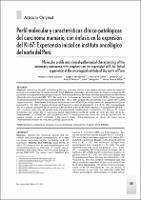Perfil molecular y características clínico-patológicas del carcinoma mamario, con énfasis en la expresión del Ki 67: Experiencia inicial en instituto oncológico del norte del Perú
Related Resource(s)
http://cmhnaaa.org.pe/ojs/index.php/rcmhnaaa/article/view/71Date
2019-01-24Author(s)
Abad-Licham, Milagros A.
Yan-Quiroz, Edgar F.
Cueva, Kristian M.
Cruz, Jaime E .
Pantoja, Andy R.
Astigueta, Juan C.
Guerra-Miller, Henry
Metadata
Show full item recordAlternate title
Molecular profile and clinical-pathological characteristics of the mammary carcinoma, with emphasis on the expression of Ki 67: Initial experience at the oncological institute of the north of Peru
Abstract
Objetivo: Identificar el perfil molecular y las características clínicas y patológicas del carcinoma de mama de acuerdo a la variabilidad en la expresión del Ki 67. Material y métodos. Serie de casos, en el que se evaluaron 157 pacientes con diagnóstico anatomopatológico e inmunohistoquímico de cáncer de mama atendidas en el IREN Norte (Perú) durante el período 2008 – 2015. Se clasificaron los tumores en Luminal A, Luminal B, HER2 y Triple negativo. Se utilizo dos puntos de corte para evaluar el Ki 67:> 14% y > 20%, de acuerdo a lo sugerido en St. Gallen 2011 y 2013 respectivamente. Resultados. En el grupo de pacientes con Ki 67 > 20%, el subtipo molecular que predominó fue el Luminal B (n = 54; 34%). El tamaño tumoral más frecuente se ubicó en el grupo de > 2 a < 5 cm. (T2), representando 56% en el subtipo Luminal B, 28% en Luminal A, 69% en HER2 y 41% en el Triple negativo. En los pacientes con Ki 67 > 14%, el subtipo molecular y el tamaño tumoral predominante también fue el Luminal B (n = 73, 46%) y el T2. El tipo histológico más común fue el carcinoma ductal independientemente del punto de corte del valor de Ki 67. Conclusiones. La utilidad del valor porcentual del Ki 67 evaluado en dos puntos de corte es controversial; en nuestro estudio el perfil molecular y las características clínico-patológicas de cáncer de mama fueron relativamente similares en relación a Luminal A y Luminal B. Objetive: Identify the molecular profile and the
clinical and pathological characteristics of breast
carcinoma according to the variability in Ki 67
expression. Material and methods. Case series, in
which 157 patients with an anatomopathological and
immunohistochemical diagnosis of breast cancer
treated at IREN Norte (Peru) were evaluated during the
period 2008-2015. The tumors were classified into
Luminal A, Luminal B, HER2 and Triple Negative. Two
cut-off points were used to evaluate Ki 67: > 14% and >
20%, according to what was suggested in St. Gallen 2011
and 2013 respectively. Results. In the group of patients
with Ki 67 > 20%, the molecular subtype that
predominated was Luminal B (n = 54, 34%). The most
frequent tumor size was in the group of > 2 to < 5 cm.
(T2), representing 56% in the Luminal B subtype, 28% in
Luminal A, 69% in HER2 and 41% in the Triple negative. In
patients with Ki 67 > 14%, the molecular subtype and
the predominant tumor size was also Luminal B (n = 73,
46%) and T2. The most common histological type was
ductal carcinoma regardless of the cut-off point of the
Ki 67 value Conclusions. The utility of the percentage
value of Ki 67 evaluated at two cut points is
controversial; in our study, the molecular profile and
clinical-pathological characteristics of breast cancer were relatively similar in relation to Luminal A and Luminal B.






